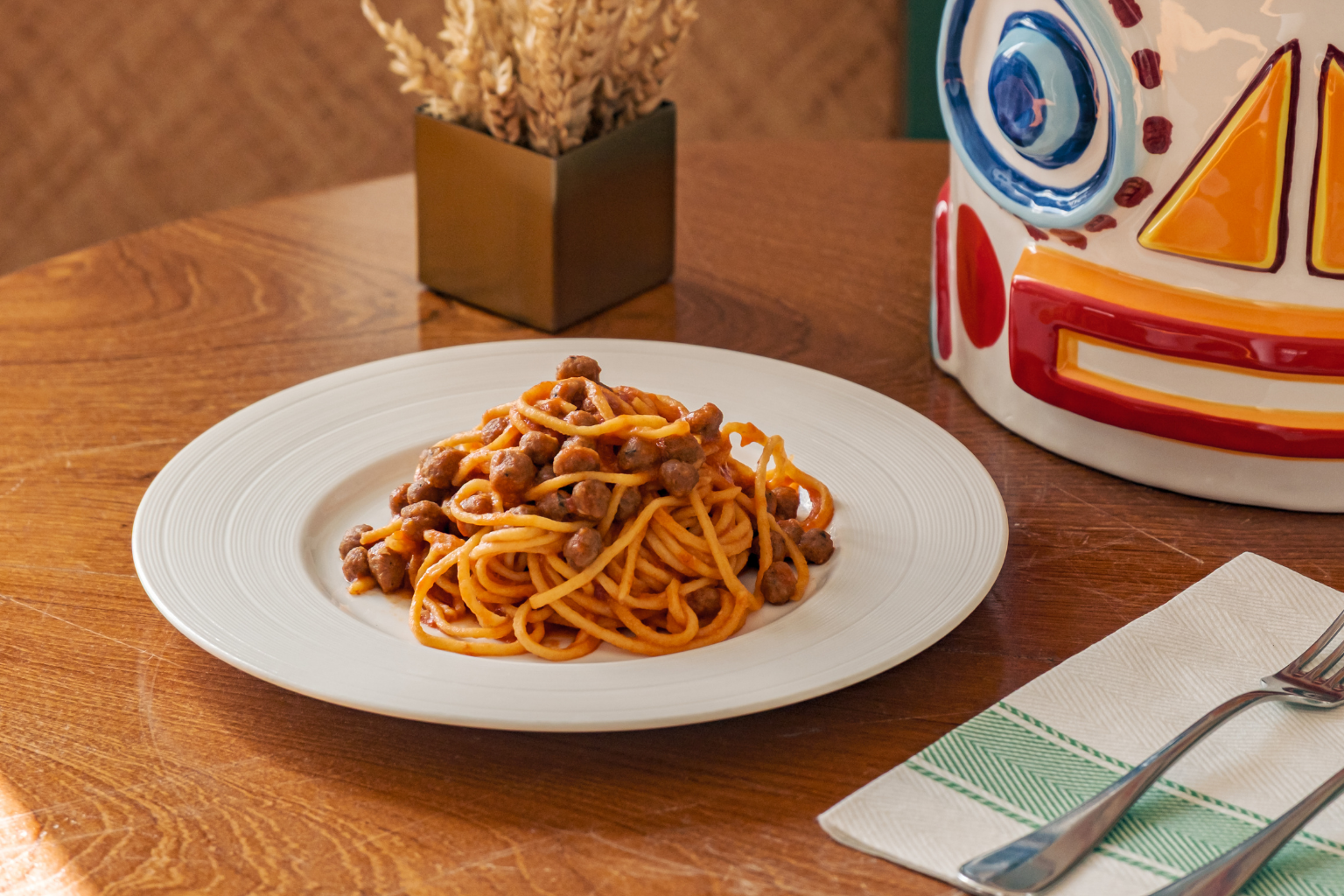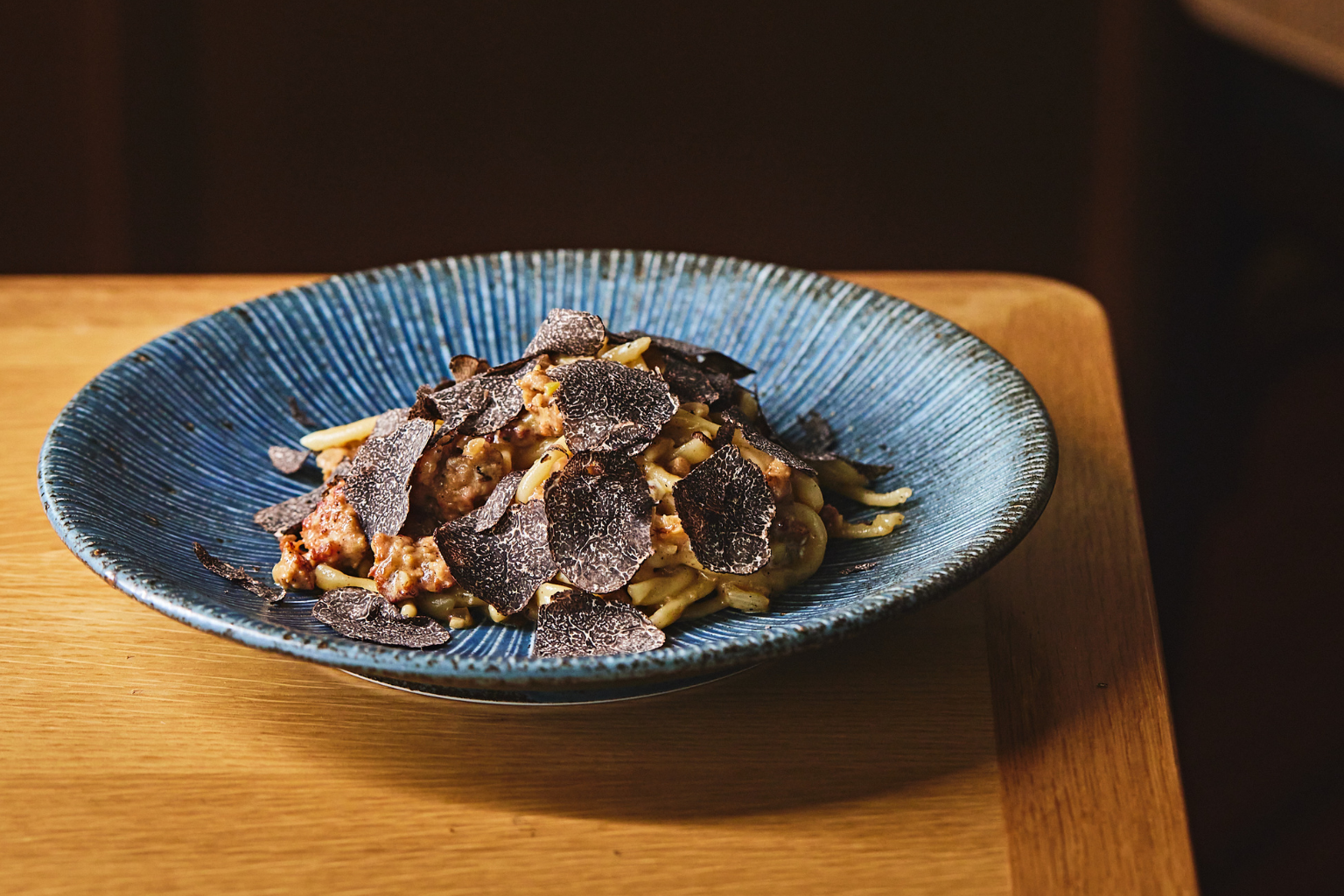SPRING
Our Pasta Programme
Every season, we shine the spotlight on a series of traditional pasta shapes fabricated using age-old techniques. Delve into their culinary anthropology, from the historical events that gave birth to them to the regional touches that have shaped them over time.
This summer, we turn to shapes that cool, comfort and quietly impress. Pasta made for long days, golden evenings and stories that stretch across centuries. From the hand-braided folds of Tortelli Piacentini, first crafted to charm the poet Petrarch, to the wriggly, sauce-loving strands of Umbricelli alla Norcina, born of Umbrian flour and foraged truffles, every dish honours its roots.
In Teramo, Chitarrine alla Teramana takes the idea of spaghetti and meatballs to another level, cut on stringed wooden frames and tossed in a sugo rich with tiny pallottine. And from the sun-soaked Amalfi Coast, Linguine al Limone brings citrus and cheese together in a sauce that’s light, bright and impossible to forget.
This season, we invite you to journey through Italy’s summer table. Bite by bite, region by region, one shape at a time.

Culurgionis d’Ogliastra
Origins: Ogliastra, Sardinia (Islands)
Hand-stitched Sardinian ravioli filled with Idaho potatoes, crab, and parsley, warmed through with butter, lemon juice, mint, and anchovies.
A pasta with a story woven into its very shape, Culurgionis d’Ogliastra is a Sardinian specialty traditionally prepared as a token of gratitude to mark the end of the wheat harvest. The closure of these hand-stitched dumplings resembles a wheat spike (spiga)—a symbol of prosperity and renewal for the agricultural year ahead. Traditionally filled with pecorino, potatoes, garlic, and mint, what you’ll find in each dumpling and the names they take on varies across towns in Ogliastra, each variation a reflection of its local palate.
Once confined to Sardinia’s rugged Ogliastra region—an island within an island, as locals say—this dish remained fiercely protected, passed down through generations of Sardinian women. So much so that the art of sealing Culurgionis by hand was once considered an essential skill for marriage readiness. Today, this pasta has earned I.G.P. status, cementing its place among Italy’s most cherished culinary treasures.
Linguine al Limone
Origins: Salerno, Campania (South)
Bronze-extruded long pasta tossed in a lemon, garlic, and mint emulsion, finished with sharp Pecorino Romano D.O.P.
A coastal staple that captures the essence of summer, this dish brings together the sun-drenched citrus of the region with Roman cheese traditions. In Campania, lemons are more than fruit; they’re a way of life, cultivated on terraced cliffs for generations. In Campania, lemons are more than fruit; they’re a way of life, cultivated on terraced cliffs for generations. Here, their zest is freshly grated over pasta coated in a sauce of butter and aged pecorino, made silky with a touch of pasta water. Mint and garlic lift the flavours for a light, creamy take on coastal Italian comfort.


Spaghetti c’anciova e muddica
Origins: Palermo, Sicily (Islands)
Bronze-extruded long pasta with anchovies, tomatoes, pine nuts, raisins and bread crumbs
A humble yet flavour-packed staple of Sicilian cuisine, Spaghetti c’anciova e muddica is a dish built on the art of making the most out of making do—a common thread in Palermo’s cucina povera past. Anchovies, tomato paste, raisins, and pine nuts create a deeply savoury yet subtly sweet sauce, made all the more satisfying with a generous sprinkle of toasted breadcrumbs, known in Sicilian dialect as muddica atturrata or “poor man’s cheese.”
This beloved recipe has no single origin story, but its ingenuity is undisputed. Some trace its roots to Sicilian emigrants yearning to recreate the flavours of home during long, dark winters in the north. Others say it emerged from the ingenuity of farm workers, relying on easily transportable and shelf-stable ingredients like anchovies and breadcrumbs. Regardless of its precise beginnings, what unites these tales is the spirit of adaptation—anchovies taking the place of seasonal sardines and breadcrumbs transforming humble leftovers into crunchy gold—the ability to transform simple, everyday ingredients into something that is spectacularly Sicilian.
Chitarrine alla Teramana
Origins: Teramo, Abruzzo (Central)
Square-cut egg pasta with beef and pork meatballs, tomato sugo, white wine, soffritto, and Pecorino Romano D.O.P.
Named after the chitarra—a traditional rectangular tool strung with steel wires, much like a guitar, from which it gets its name. Pasta sheets are rolled over the frame to produce square-edged strands that are firm and ridged to hold hearty sauces beautifully.
Ours adds a subtle lift and sharpness to the rich tomato sugo with a splash of white wine and Pecorino Romano D.O.P. What makes the dish instantly recognisable are the pallottine—tiny meatballs no larger than chickpeas that finish the sauce. A glorious preparation of spaghetti and meatballs from Abruzzo, but on a whole other level.


Tortelli Piacentini
Origins: Piacenza, Emilia-Romagna (North)
Hand-folded egg pasta filled with ricotta and nutmeg, served with butter, Parmigiano Reggiano, and aged balsamic vinegar
A 14th-century invention from Emilia-Romagna, first crafted to impress the poet Petrarch during a visit to the Castle of Vigolzone. Legend has it that nobleman Bernardo Anguissola requested something more elegant than everyday ravioli—what emerged was a shape both refined and striking. Each tortello is formed into a distinctive pinched braid, shaped entirely by hand through a meticulous process of folding, plaiting, and pleating.
Traditionally, they are filled with a mixture of ricotta, spinach, nutmeg, and Grana Padano. At Forma, we pare it back to just ricotta and nutmeg—warmed through in butter and Parmigiano Reggiano, then finished simply with a few drops of aged balsamic vinegar to give it a bright lift. A dish of quiet detail and historic charm.
Umbricelli alla Norcina
Origins: Norcia, Umbria (Central)
Hand-extruded long pasta with Italian pork sausage, black truffles, nutmeg, white wine, and Pecorino Romano Crosta Nera D.O.P.
Thick, chewy, and a little wriggly, Umbricelli gets its name from “umbrico”, the local word for “earthworm.” Name aside, it’s a shape beloved across Umbria’s hill towns, thought to have originated in the comuni of Spoleto and Foligno. Hand-rolled from just flour and water, this eggless pasta has graced Umbrian tables for generations, prized for its springy bite and sauce-gripping curves.
Ours is tossed alla Norcina, a heady sauce from the town of Norcia, celebrated for its norcini, expert pork butchers whose craft dates back to Roman times. Black truffles bring depth and aroma, while crumbled sausage, white wine, nutmeg, and Pecorino Romano Crosta Nera round out the dish with richness, warmth, and a touch of sharpness.


Trenette allo Scoglio
Origins: Genoa, Liguria (North-West)
Bronze-extruded long pasta with a medley of seafood including tiger prawns, mussels, manila clams, scallops, and grilled calamari, cooked in a lobster butter sauce.
Available in limited quantities as a special only
Trenette allo Scoglio, a celebrated dish from the enchanting coastal region of Liguria, Italy, captures the very essence of the Mediterranean’s bountiful waters. Trenette is a long, flat pasta similar to linguine, traditionally made from semolina and water. The name “allo Scoglio”, meaning “on the rocks,” evokes the rugged beauty of the rocky Ligurian coastline, where fresh seafood is abundant. This pasta features a luxurious medley of seafood such as clams, mussels, shrimp, and squid, all sautéed with fragrant garlic, vibrant cherry tomatoes, and a splash of white wine to create a savoury sauce. At Forma, we double down on indulgence by coating the entire dish in a velvety lobster butter sauce. The history of Trenette allo Scoglio is deeply intertwined with the maritime culture of Liguria, where fishing has been a way of life for centuries. Ligurian fishermen would often prepare this dish using their daily catch, embodying the region’s tradition of simplicity, freshness, and robust flavors. Over time, Trenette allo Scoglio has become a staple of Ligurian cuisine, celebrated for its authentic taste of the sea and its reflection of the region’s rich culinary heritage.

